Oct-19-18
 | | Jonathan Sarfati: Ironically, this Black defence would later be played by Marshall himself and even sometimes named for him, e.g. Reti vs Marshall, 1924 and Alekhine vs Marshall, 1925 |
|
| Feb-11-22 | | Stolzenberg: White should not allow the pawn d5 to survive, so 9. exd5 was better, as White could answer 9. ... e4 with 10. Nxe4. |
|
Apr-02-22
 | | KEG: After his spectacular third-place showing at Paris 1900, Marshall's 1901 must have been a major disappointment for him. As Marshall's opponents soon recognized that year, his play--though sometimes brilliant--was spotty and he became easy prey for the top opponents. At the beginning of this tournament (Monte Carlo 1902) Marshall's play and luck seemed to have returned to its Paris 1900 level. Going into this game, Marshall had scored 4.5 points out of a possible 5.5, including a win over Tarrasch from a hopelessly lost ending. Beginning in the instant game, however, Marshall's fortunes at Monte Carlo 1902 changed, and he wound up in ninth place (out of 20). The unsoundness of Marshall's game at this stage of his career (and before his fabulous breakthrough a Cambridge Springs 1904) is exemplified in this encounter against Gunsberg. Against Gunsberg's unusual defense to the Queen's Gambit, Marshall misplayed the opening horrendously and managed to achieve something close to a strategically lost game by move 9, and as White to boot. Later sloppy and indifferent play by Gunsberg game Marshall chances to get back in the game, but further wild and careless play--most notably his blunder on move 36-allowed Gunsberg to wrap up nicely. 1. d4 d5
2. c4 Nf6

click for larger viewAs <Jonathan Safarti> notes, Marshall later came to play this line himself as Black. While not the world's best way to combat the Queen's Gambit, the text is certainly playable. 3. cxd5 Nxd5
With a more gambit-prone player, one might expect something like 3...g6 or 3...c6 or 3...e6. But this was hardly Gunsberg's style, and he simply got an inferior position for his opening choice. 4. e4 Nf6
4...Nb6 is perhaps somewhat better, but Black is worse whatever he does here. 5. Nc3
The Tournament Book called this "inferior," but it looks best to me considerably better than the committal 5. Bd3 recommended by the Tournament Book. 5... e5!

click for larger view"Now Black at least equalizes the game, thus paying no penalty for the venturesome opening moves." (Tournament Book), Sorry, but if Marshall had kept his head and not gone haywire, Gunsberg would have emerged from the opening with a very difficult game. 6. d5?!
This first of several wild moves by Marshall converted a superior position for White to something close to a lost game in just a few moves. Here Marshall could have claimed a significant edge with 6. dxe5 QxQ+ 7. KxQ Ng4 8. Nd5 or, more simply, with 6. Nf3. 6... Bc5?!
This only worked because of Marshall's zany play. Gunsberg would have had approximately equal chances with 6...c6. 7. Be2
Marshall seemed worried about Ng4 by Black. But he could just have played the natural 7. Nf3 and if then 7...Ng4 White has much the better game after 8. Bb5+ c6 9. dxc6 QxQ+ 10. NxQ bxc6 11. Ba4 (or 11. Bd3). 7... c6
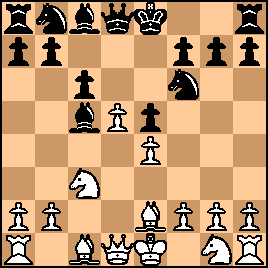
click for larger view8. Nf3
"He had nothing better now than 8. dxc6." (Tournament Book) Nonsense. Black gets the better game after 8. dxc6 QxQ+ 9. BxQ Nxc6. The text is the only way Marshall can retain any advantage from this strange opening. 8... cxd5
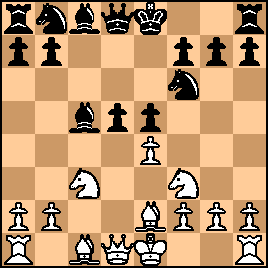
click for larger viewAs it turned out, this proved to be the crucial moment in the game, since Marshall now made another of the wild moves that plagued his play in 1901 and got himself into a fix from which he was never able to extricate himself. |
|
Apr-02-22
 | | KEG: Post II
9. Bg5?!
"This move practically loses the game. White gets no compensation in attack or otherwise for allowing Black to remain a pawn ahead, and, what is more, a passed pawn." (Tournament Book). " White should not allow the pawn d5 to survive, so 9. exd5 was better, as White could answer 9. ... e4 with 10. Nxe4." (<Stolzenberg>) The text does indeed put Marshall on the cusp of defeat. And <Stolzenberg> is quite correct that 9. exd5 is best for White here. It would have left Marshall with a small edge. But after 9. exd5, 9...e4?! would be a mistake, not so much because of 10. Nxe4 (after which, of course, 10...NxN gets answered by 11. Qa4+ which leaves White a pawn to the good with a likely won game) but because of the much stronger 10. Ng5!. Instead of 9...e4, Black should play 9...0-0 or 9...Nbd7 with a slightly inferior but entirely playable game. After Marshall's dreadful 9. Bg5, the position was: 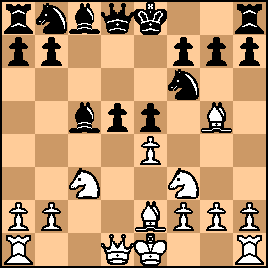
click for larger view9... d4
Of course. Now Marshall would have had serious problems whatever he did, but especially after: 10. Nd5?!
10. BxN QxB 11. Nd5 Qd6 still leaves Marshall down a protected passed pawn, but this is better than what he got after the text. 10... Be7!
"The move Marshall must have overlooked. He is compelled to exchange, Black threatening NxN winning a piece." (Tournament Book) 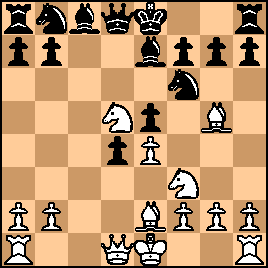
click for larger view11. NxB
11. BxN BxB was certainly no better.
11... QxB
12. 0-0 Nc6
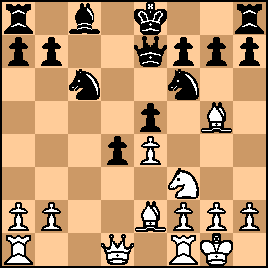
click for larger viewQuite a disheartening position to hold as White after only 12 moves. The Black d-pawn is a monster, and White has at most scant compensation for the lost pawn. 13. Nd2
"Anticipating Black's dislodging the Bishop, and not being inclined to change another piece, being a pawn behind, he must defend the e-pawn." (Tournament Book) The above is all correct, but the text hardly looks best. Marshall had perhaps better chances of digging out of the hole he had made for himself with 13. Bd3 or 13. Bh4. 13... h6
14. Bh4 g5?!
There of course is merit in driving away the Bishop, but Gunsberg now had King-side weaknesses; always a danger against an attacking wizard such as Marshall. 14...0-0 or 14...Bd7 seem easier ways to try to capitalize on Black's obvious advantages. 15. Bg3 0-0

click for larger viewGunsberg's suddenly exposed square on the King-side were too much for Marshall to resist, and as will be seen he now embarked on an unsound attacking scheme that could have led to immediate disaster had Gunsberg kept his head. |
|
Apr-02-22
 | | perfidious: <KEG>, 4.Nf3 has long been known to be stronger than Marshall's actual line. |
|
Apr-02-22
 | | KEG: <perfidious> Both moves look fine to me, and 4. e4 was played at least four times by Alekhine in tournaments (and numerous times in simuls). You may or may not be correct that 4. Nf3 is theoretically stronger, but 4. e4 had little to do with Marshall's loss here. |
|
Apr-02-22
 | | KEG: Post III
16. h4?!
This was over-the-top by Marshall, and allowed a pretty shot by Gunsberg, the position not being: 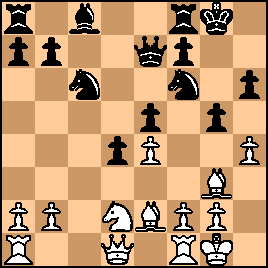
click for larger view16... Ne8?
Missing his chance. Needless to say, Gunsberg could just have played 16...Rd8 and had much the better game. But the most forcing continuation after Marshall's lemon was 16...d3! While Gunsberg was understandably reluctant to part with his protected passed pawn in the center, 16...d3 seems to win. Play might then have continued 17. Bxd3 Rd8 18. Nb3 Nb4 19. Nc1 Nxe4 20. Qe2 NxB 21. fxN Be6 after which Black is a pawn up (a passed e-pawn in the center) with strong play on both wings with a likely win. After the clumsy text, Marshall had some chances. 17. hxg5 hxg5
18. Rc1 Be6
"Bc7 at once would have saved a move." (Tournament Book) Perhaps, but best for Black and still yielding the significantly better game for Black were 18...f6 or 18...Nd6. After the text, things got interesting, the position now being: 
click for larger view19. Bb5
19. Nb3 looks like the sound choice, but I am shocked that Marshall of all people did not try: 19. RxN. Play might then have continued 19...bxR 20. Bxe5 Rd8 21. Bd3 Bxa2 22. Bh2 Be6 23. Qh5 with some compensation and attacking chances for the sacrificed exchange. Marshall's move was hardly a blunder, but it does not seem to do much for getting him back in the game. 19... Bd7
19...f6 was still probably strongest.
20. a3
Another nothing move by Marshall, who seems at times to have given up and at others to have decided to fight to the death and go on the attack. There were plenty of good alternatives: 20. Nb3; 20. Bc4; 20. Qa4; 20. Qb3 and maybe even 20. Bd3. 20... f6
21. Nb3
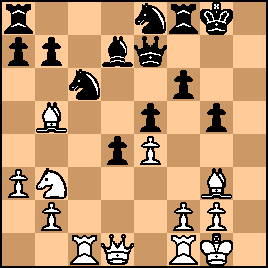
click for larger viewGunsberg was again on the cusp of victory, but here he hung a piece---and Marshall missed it! 21... Nc7?
Black is likely winning with 21...Rc8 or 21...Nd6, but now the Black Knight on c7 is loose: 
click for larger viewNow, thanks to the undefended Knight on c7, Marshall can regain the lost pawn and eliminate the Black passed d-pawn with 22. Nxd4! I would expect most decent club players to spot this in a nano-second. But Marshall somehow missed it and played: 22. Bd3?
This was the beginning of a series of bizarrely weak moves by both sides. Was time pressure (there was a move-30 time control) the reason? I have no idea, but I can say that the next portion of the game was almost painful to play over. In any case, the position after 22. Bd3? was:

click for larger view |
|
Apr-02-22
 | | KEG: Post IV
22... Na6?
A truly horrible move. What--is anything--was Gunsberg thinking? Having earlier played the ridiculous 16...Ne8, over the course of the next five moves, he played 22...Na6; 25...Nc7 and 26...Ne8. This was his plan to exploit his winning position? As bad as Gunsberg's plan was, this move--like 21...Nc7, was a tactical blunder. After Marshall's awful 22. Bd3?, Gunsberg again had a won game, and with 22...Ne6 his Knight would no longer be hanging and he would be well on his way to victory. But after 22...Na6?, the position was: 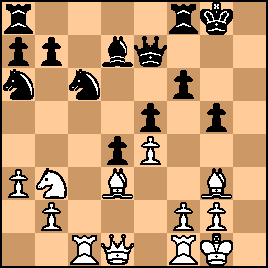
click for larger viewNow, Marshall could have messed up Gunsberg's position good and proper with the fairly obvious 23. BxN. But Marshall instead played: 23. Bc4+
Since the Knight can still be taken on White's next move, this didn't really ruin anything for Marshall...yet. 23... Kg7
Marshall now had a choice of decent moves. He could have fortified his e-pawn with 24. f4 or 24. Re1 or 24. Nd2, or--better still--he could have just taken Black's a6 Knight and--as was possible on his prior move--messed up Black's pawn structure. But Marshall decided not to give up his two Bishops and played: 24. Bd5?
This did fortify his pawn on e4, but not Black's Knight on a6 is safe from capture, and now Gunsberg could start to press his edge by challenging White on the c-file: 24... Rac8
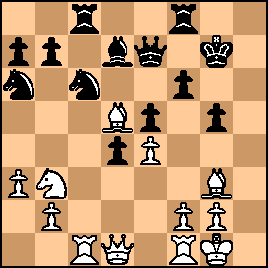
click for larger view25. Nd2 Nc7
Having made one useful move (24...Rac8), Gunsberg went back to playing zombie. 26. Ne1 Ne8
Back to the same useless square this Knight had occupied prior to his weird Knight wandering. 27. f3 Nd6
After this steed's meaningless wanderings, Gunsberg finally brought it to a square where it might be of some use to him: 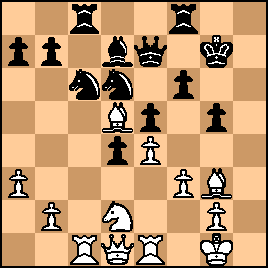
click for larger view28. Qa4?
A worse than useless adventure by the White Queen. If Marshall's next moves are any indication of what he was thinking, the plan was to bring the Queen to b2. But...I still don't get it. 28... Rc7
The best way to defend the Black pawn on a7 and a potential step towards doubling up Rooks on the c-file. A rare good move by Gunsberg in this lamentable portion of this game. 29. b4?
This must be the result of time pressure. Nothing is great for Marshall here, and 29. BxN is probably the best move at his disposal. 29... a6
Rather than fret about his (already well-defended) a-pawn, Gunsberg should have continued his Queen-side plan by doubling-up his Rooks on the c-file with 29...Rfc8. 30. Qb3 Rfc8
Better late than never.
The move-30 time control had been reached, and the board now looked like this: 
click for larger view |
|
Apr-02-22
 | | KEG: Post V
Gunsberg, who had played what I called zombie chess for the moves before reaching the time to control now buckled down to win what had been a winning or near-winning position for most of the game. He was still a pawn ahead, and his protected passed d-pawn was still more than White could reasonably handle. 31. Qb2 Be6
32. Nb3 b6
33. Qe2
This targeting of the Black a6 pawn got Marshall nowhere. 33... Qf7
"Black is at last on the right track, which the remainder of the game evidences, being marked by less undefined maneuvering as thitherto." (Tournament Book) 
click for larger view34. BxB
34. Qxa6 would have been even worse: 34...BxB 35. exB Qxd5 36. Nd2 Qb5 37. QxQ (forced) NxQ with an easy win for Black. 34... QxB
35. Qd3
35. Nd2 or 35. Qb2 were arguably better, but neither would have had much chance to changes the outcome of the game. 35... Nb5!
Ouch!
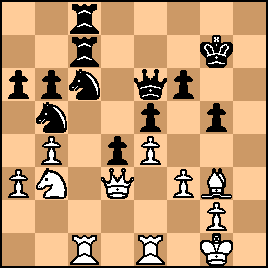
click for larger view36. Re2?
"Better would have been 36. Nd2; he [Marshall] played for a trap, which however, turned out [to be] a trap against himself." (Tournament Book) Marshall's tactical prowess deserted him here, and Gunsberg was now able to close out the game with a pretty combination. But while 36. Nd2 was perhaps less instantly catastrophic, the game was gone anyway so condemning Marshall here is somewhat unfair. 36... Nxb4!
"Sound and speedy, although obvious." (Tournament Book) 
click for larger view37. RxR+ RxR
38. axN Rc3

click for larger view39. Nxd4 NxN
"Showing that Black saw further ahead than White. Obviously White cannot capture the Rook." 
click for larger view40. Qxa6
Of course, if 40. QxR NxR+ loses the Queen.
40... NxR+
41. QxN Qc4

click for larger view41...Rc1+ or the quite 41...Qc8 also win easily. 42. Qd2
41. QxQ was also entirely hopeless.
42... Qd4+
43. QxQ exQ
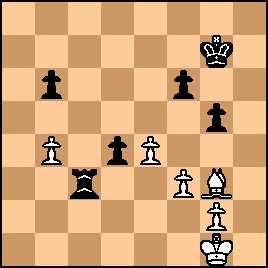
click for larger viewFor whatever reason, Marshall chose to play on. Further resistance was futile, but--as I will discuss on my next post on this game--it did allow Gunsberg to pull off a neat endgame finish. |
|
Apr-02-22
 | | KEG: Post VI
44. Kf1 Rc2
44...d3 immediately is also crushing.
45. b5
Now, of course, Black can pick up the undefendable b-pawn at his leisure. But Marshall had nothing much better. 45... d3
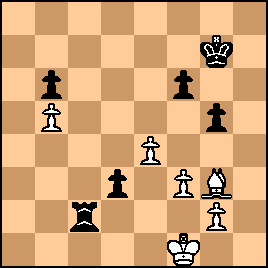
click for larger viewIf Marshall had some notion that Gunsberg would lose on time, now that the move 45-time control had passed there seems no reason for White to play on. But Marshall decided attempt an obviously doomed attack. Oh well, why not. 46. Ke1
Leaving the g-pawn to its fate.
46... Kf7
Not even deigning to take the White g-pawn, and instead making sure Marshall could not play Bc7 and win the Black b-pawn. 47. Kd1
Daring Gunsberg to take the g-pawn.
47... Ke6
Proceeding merrily on his winning course.
48. f4
A final wild desperate (and completely hopeless) attempt to complicate. 
click for larger view48... Rxg2
49. f5+ Kd7
50. Be1
Setting up a cute finish for Black.
50... Rg1
51. Kd2
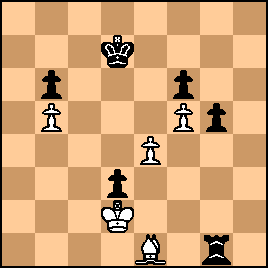
click for larger view51... RxB
"The shortest way." (Tournament Book)
52. KxR g4
53. Kd2 g3
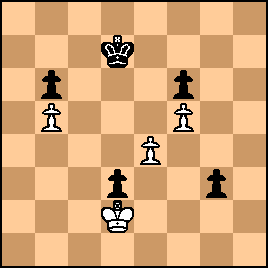
click for larger view0-1 |
|
|
|
|





